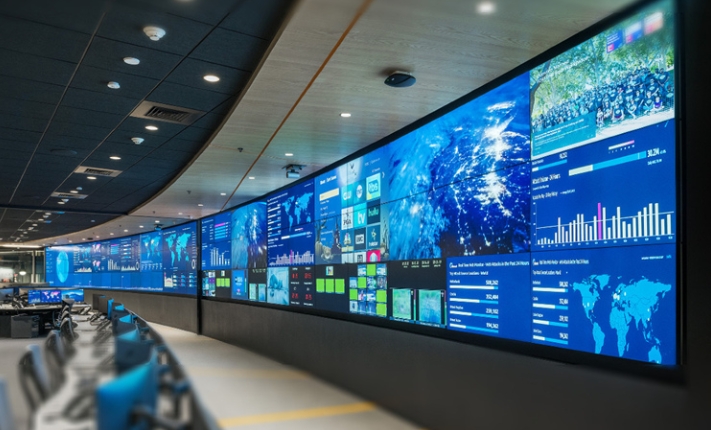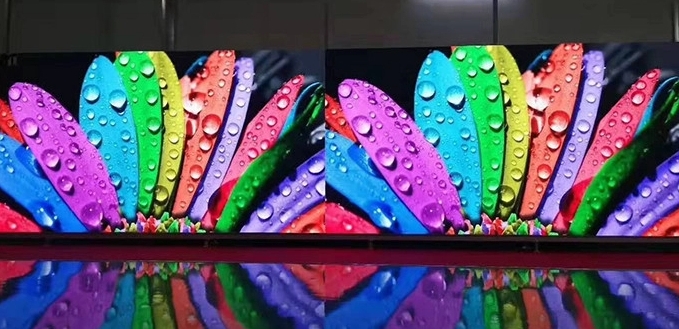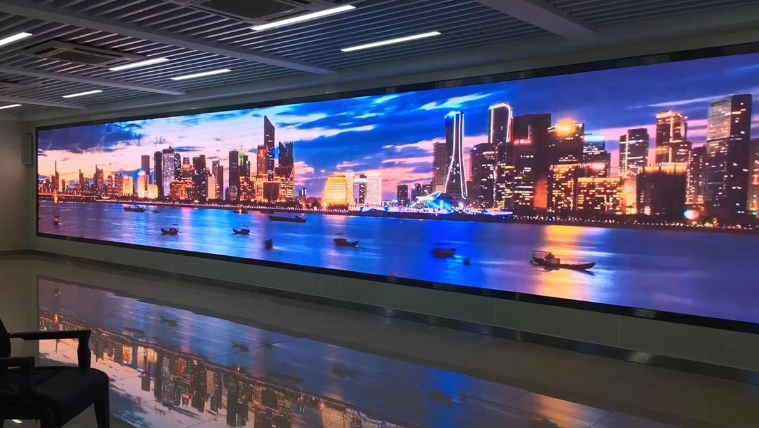A small pitch LED display refers to a type of indoor LED display that has a small pixel pitch meaning the distance between adjacent pixels is very small, which is usually under P2.5 (2.5mm pixel pitch). This results in a high pixel density and allows for the display of detailed and high-resolution images and videos. Small pitch LED displays are commonly used in applications where image quality and clarity are crucial, such as studios, monitoring rooms, art exhibitions, and other environments with high-quality requirements for images or videos.

There are several different technologies used in small pitch LED displays. Here are some of the commonly used technologies:
Surface Mount Device (SMD) LED: SMD LEDs are the most common type used in LED displays. They are small, compact, and provide good color reproduction. SMD LEDs are mounted onto the surface of the display module, allowing for a fine pixel pitch and high pixel density.
Chip-on-Board (COB) LED: COB technology involves mounting multiple LED chips directly onto a circuit board, creating a densely packed LED module. COB LEDs offer advantages such as high brightness, better heat dissipation, and smaller dot pitches compared to SMD LEDs. COB technology is often used in small pitch LED displays for its superior performance and reliability.
Mini LED: Mini LED is a relatively new technology that uses smaller-sized LED chips compared to traditional SMD LEDs. Mini LEDs offer improved brightness, contrast, and color reproduction. The smaller LED size allows for finer pixel pitches, enhancing the overall image quality and detail.

Kinglight mini and micro LEDs for small pitch LED displays
Micro LED: Micro LED displays use even smaller LED chips compared to Mini LEDs. Micro LEDs are typically less than 100 micrometers in size and offer exceptional pixel density and image quality. They provide high brightness, contrast, and color accuracy, making them suitable for applications that demand the utmost visual performance.
Organic Light-Emitting Diode (OLED): While OLED displays are more commonly associated with small-sized screens like smartphones and televisions, they can also be used in small pitch LED displays. OLED technology uses organic compounds that emit light when an electric current is passed through them. OLED displays offer excellent color reproduction, wide viewing angles, and the ability to achieve true blacks, resulting in high contrast ratios.
Each of these technologies has its own advantages and considerations, and the choice of technology depends on the specific requirements of the application, budget, and desired visual performance.

Small pitch LED displays offer several advantages compared to other display technologies. Here are some key advantages of small pitch LED displays:
High Resolution and Pixel Density: Small pitch LED displays have a high pixel density due to their small pixel pitch, resulting in sharp and detailed images. They can display content with exceptional clarity, making them suitable for applications where image quality is crucial.
Seamless and Uniform Display: Small pitch LED displays have a seamless design with minimal bezels or gaps between the individual LED modules. This creates a uniform and continuous visual experience, allowing for immersive content presentation without distractions.
Wide Viewing Angle: LED technology provides wide viewing angles, ensuring that the content remains visible and vibrant even from different perspectives. This makes small pitch LED displays suitable for environments where viewers may be positioned at various angles.
Brightness and Color Accuracy: Small pitch LED displays offer high brightness levels, allowing them to deliver vivid and vibrant visuals even in well-lit environments. Additionally, they provide excellent color accuracy, ensuring that the displayed content appears true to life.
Flexibility and Customization: LED modules used in small pitch LED displays are flexible and can be bent to fit curved surfaces or customized to various sizes and shapes. This flexibility enables creative and unique display installations that can enhance the visual impact of the content.
Energy Efficiency: LED technology is known for its energy efficiency. Small pitch LED displays consume less power compared to traditional display technologies, resulting in lower energy costs and reduced environmental impact.
Longevity and Durability: LED displays have a long operational lifespan, often exceeding tens of thousands of hours of usage. They are built to withstand frequent usage and are resistant to shocks, vibrations, and temperature variations, ensuring long-lasting performance.
Real-time Content Updates: Small pitch LED displays can be easily controlled and updated in real-time. This allows for dynamic content management, enabling businesses to display timely information, advertisements, promotions, or event updates efficiently.
These advantages make small pitch LED displays ideal for a wide range of applications, including control rooms, command centers, broadcast studios, retail displays, digital signage, and more.

Small pitch LED displays are suitable for a wide range of applications and environments where high-quality visuals, clarity, and flexibility are essential. Here are some examples of individuals and entities that might need small pitch LED displays:
Broadcast Studios: Broadcasters, production houses, and news stations can use small pitch LED displays for on-set displays, virtual reality sets, and to enhance the overall visual quality of their productions.
Control Rooms and Command Centers: Small pitch LED displays can be used in control rooms and command centers to display real-time data, analytics, and visuals for monitoring and managing complex systems, networks, or processes.
Art and Museum Exhibits: Artists and museums can use small pitch LED displays for immersive and engaging artistic installations, interactive exhibits, or to display high-resolution images and videos in a visually appealing manner.
Retail and Shopping Malls: Small pitch LED displays can be used in retail stores and shopping malls for digital signage, advertising, and promotional purposes, enhancing customer engagement and sales.
Corporate Environments: Businesses and organizations can use small pitch LED displays for conference rooms, boardrooms, lobby displays, or as interactive wall panels, contributing to a professional and modern visual experience.
Sports and Entertainment: Small pitch LED displays can be used in stadiums, arenas, and amusement parks to deliver high-quality visuals, live game feeds, and promotional content, enhancing the overall experience for fans and attendees.
Public Information and Transportation: Small pitch LED displays can be used in public transportation hubs, such as airports, train stations, and bus terminals, to display real-time information, schedules, and wayfinding, improving the overall user experience.
Education and Research Institutions: Educational facilities, research centers, and laboratories can use small pitch LED displays for interactive learning, research, and collaboration, enhancing the educational and research experience.
Hospitality and Entertainment: Hotels, bars, restaurants, and casinos can use small pitch LED displays for wayfinding, menu boards, promotional content, and ambiance, creating an engaging and immersive visual experience.
Security and Monitoring: Security and monitoring facilities, such as surveillance centers, can use small pitch LED displays to monitor and manage real-time data, analytics, and visuals, ensuring effective surveillance and incident management.
These are just a few examples of the entities and individuals that might need small pitch LED displays. The technology is versatile and can be adapted to various applications, depending on specific visual and functional requirements.